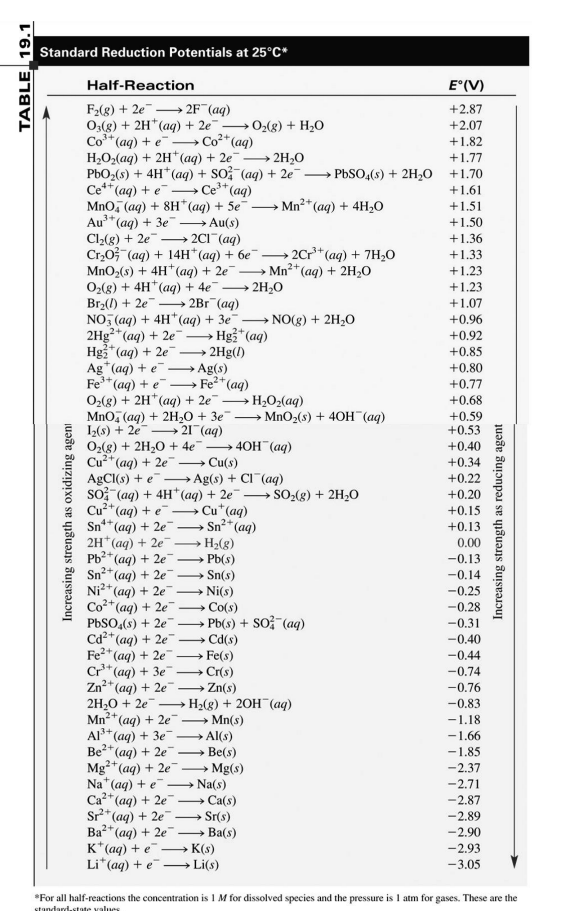2NaCl(aq) + 2H2O(l) → 2NaOH(aq) + Cl2 (g) + H2(g) a) An electrolysis is a redox reaction. What substance is oxidized, and what substance is reduced in the electrolysis of the solution with sodium chloride NaCl(aq)? Base your answer by showing to change in oxidation figures.
2NaCl(aq) + 2H2O(l) → 2NaOH(aq) + Cl2 (g) + H2(g) a) An electrolysis is a redox reaction. What substance is oxidized, and what substance is reduced in the electrolysis of the solution with sodium chloride NaCl(aq)? Base your answer by showing to change in oxidation figures.
Chemistry & Chemical Reactivity
10th Edition
ISBN:9781337399074
Author:John C. Kotz, Paul M. Treichel, John Townsend, David Treichel
Publisher:John C. Kotz, Paul M. Treichel, John Townsend, David Treichel
Chapter19: Principles Of Chemical Reactivity: Electron Transfer Reactions
Section: Chapter Questions
Problem 94GQ: A voltaic cell is constructed in which one half-cell consists of a silver wire in an aqueous...
Related questions
Question
In an electrolysis of a solution with sodium chloride NaCl(aq), sodium hydroxide is formed NaOH(aq), chlorine gas Cl2(g), and hydrogen gas H2(g), after the reaction equation:
2NaCl(aq) + 2H2O(l) → 2NaOH(aq) + Cl2 (g) + H2(g)
a) An electrolysis is a redox reaction. What substance is oxidized, and what substance is reduced in the electrolysis of the solution with sodium chloride NaCl(aq)? Base your answer by showing to change in oxidation figures.
b) Use the table at the back of the task set and set up two half-reactions describing what is happening on the anode and cathode of this electrolysis.

Transcribed Image Text:TABLE 19.1
Standard Reduction Potentials at 25°C*
Half-Reaction
E° (V)
F₂(g) + 2e →→→→2F (aq)
+2.87
+2.07
O3(g) + 2H+ (aq) + 2eO₂(g) + H₂O
Co³+ (aq) + e- Co²+ (aq)
3+
+1.82
H₂O₂(aq) + 2H+ (aq) + 2e → → 2H₂O
+1.77
PbO₂ (s) + 4H+ (aq) + SO4 (aq) + 2ePbSO4(s) + 2H₂O
+1.70
4+
3+
Ce¹+ (aq) + e
Ce³+ (aq)
+1.61
2+
MnO, (aq) + 8H* (aq) + Se →
Mn²+ (aq) + 4H₂O
+1.51
3+
Au³+ (aq) + 3e. → Au(s)
+1.50
Cl₂(g) + 2e →→→→→→→2Cl¯ (aq)
+1.36
+1.33
2+
+1.23
+1.23
Cr₂O (aq) + 14H* (aq) + 6e7 →→2Cr³+ (aq) + 7H₂O
MnO₂(s) + 4H+ (aq) + 2e7 →→Mn²+ (aq) + 2H₂O
O₂(g) + 4H+ (aq) + 4e¯¯ →→→ 2H₂O
Br₂() +2e7 →→→→2Br (aq)
NO3(aq) + 4H+ (aq) + 3e¯
2Hg²+ (aq) + 2e →
Hg+ (aq) + 2e -
+1.07
NO(g) + 2H₂O
+0.96
Hg2+ (aq)
+0.92
2Hg(1)
+0.85
Ag(s)
+0.80
>Fe²+ (aq)
+0.77
> H₂O₂(aq)
+0.68
Ag (aq) + e -
Fe³+ (aq) + e
O₂(g) + 2H+ (aq) + 2e¯
MnO4 (aq) + 2H₂O + 3e7
I₂(s) + 2e21 (aq)
O₂(g) + 2H₂O + 4e¯
Cu²+ (aq) + 2e → Cu(s)
- MnO₂(s) + 4OH(aq)
+0.59
+0.53
4OH(aq)
+0.40
+0.34
AgCl(s) + e - Ag(s) + Cl(aq)
+0.22
SO (aq) + 4H+ (aq) + 2e¯¯
> SO₂(g) + 2H₂O
:
+0.20
2+
+0.15
Cu²+ (aq) + e →
Sn¹+ (aq) + 2e
2H(aq) + 2e7
Pb²+ (aq) + 2e7
Sn²+ (aq) + 2e7
Cu+ (aq)
→→→→Sn²+ (aq)
→ H₂(g)
+0.13
0.00
Pb(s)
-0.13
Sn(s)
-0.14
Ni²+ (aq) + 2e7 →→→→Ni(s)
-0.25
→ Co(s)
-0.28
→
Pb(s) + SO³(aq)
-0.31
Co²+ (aq) + 2e
PbSO4(s) + 2e7
Cd²+ (aq) + 2e
Fe²+ (aq) + 2e7
-0.40
-Cd(s)
→ Fe(s)
→ Cr(s)
-0.44
Cr³+ (aq) + 3e7
-0.74
Zn²+ (aq) + 2e →→→ Zn(s)
-0.76
2H₂O + 2e →→→ H₂(g) + 2OH(aq)
-0.83
2+
Mn²+ (aq) + 2e
→ Mn(s)
-1.18
→Al(s)
-1.66
Al³+ (aq) + 3e7
Be²+ (aq) + 2e
→ Be(s)
-1.85
Mg²+ (aq) + 2e
→→→→Mg(s)
-2.37
Na (aq) + e →→→→Na(s)
-2.71
-2.87
-2.89
Ca²+ (aq) + 2e7 → Ca(s)
Sr²+ (aq) + 2e7 → Sr(s)
Ba2+ (aq) + 2e7 →→→→Ba(s)
K+ (aq) + e→→→→→→→K(s)
Lit(aq) + e→→→→→→Li(s)
-2.90
-2.93
-3.05
*For all half-reactions the concentration is 1 M for dissolved species and the pressure is 1 atm for gases. These are the
standard.state values
Increasing strength as oxidizing ageni
Increasing strength as reducing agent
Expert Solution
This question has been solved!
Explore an expertly crafted, step-by-step solution for a thorough understanding of key concepts.
Step by step
Solved in 2 steps with 1 images

Knowledge Booster
Learn more about
Need a deep-dive on the concept behind this application? Look no further. Learn more about this topic, chemistry and related others by exploring similar questions and additional content below.Recommended textbooks for you

Chemistry & Chemical Reactivity
Chemistry
ISBN:
9781337399074
Author:
John C. Kotz, Paul M. Treichel, John Townsend, David Treichel
Publisher:
Cengage Learning

Chemistry & Chemical Reactivity
Chemistry
ISBN:
9781133949640
Author:
John C. Kotz, Paul M. Treichel, John Townsend, David Treichel
Publisher:
Cengage Learning

Chemistry: Principles and Practice
Chemistry
ISBN:
9780534420123
Author:
Daniel L. Reger, Scott R. Goode, David W. Ball, Edward Mercer
Publisher:
Cengage Learning

Chemistry & Chemical Reactivity
Chemistry
ISBN:
9781337399074
Author:
John C. Kotz, Paul M. Treichel, John Townsend, David Treichel
Publisher:
Cengage Learning

Chemistry & Chemical Reactivity
Chemistry
ISBN:
9781133949640
Author:
John C. Kotz, Paul M. Treichel, John Townsend, David Treichel
Publisher:
Cengage Learning

Chemistry: Principles and Practice
Chemistry
ISBN:
9780534420123
Author:
Daniel L. Reger, Scott R. Goode, David W. Ball, Edward Mercer
Publisher:
Cengage Learning

General Chemistry - Standalone book (MindTap Cour…
Chemistry
ISBN:
9781305580343
Author:
Steven D. Gammon, Ebbing, Darrell Ebbing, Steven D., Darrell; Gammon, Darrell Ebbing; Steven D. Gammon, Darrell D.; Gammon, Ebbing; Steven D. Gammon; Darrell
Publisher:
Cengage Learning

Chemistry: The Molecular Science
Chemistry
ISBN:
9781285199047
Author:
John W. Moore, Conrad L. Stanitski
Publisher:
Cengage Learning

Principles of Modern Chemistry
Chemistry
ISBN:
9781305079113
Author:
David W. Oxtoby, H. Pat Gillis, Laurie J. Butler
Publisher:
Cengage Learning